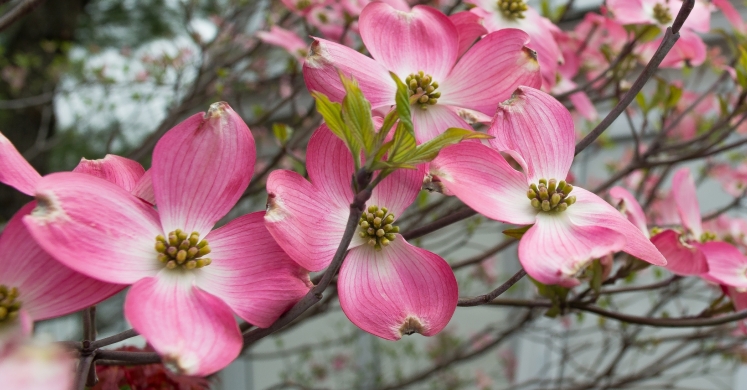Blog

#bioPGH Blog: Dogwood
 A resource of Biophilia: Pittsburgh, #bioPGH is a weekly blog and social media series that aims to encourage both children and adults to reconnect with nature and enjoy what each of our distinctive seasons has to offer. From the best times to plant seasonal flora and enjoy their peak blooms, to astronomical events and creatures to keep an eye and ear out for, Phipps will keep you in the know with what’s going on in our environment!
A resource of Biophilia: Pittsburgh, #bioPGH is a weekly blog and social media series that aims to encourage both children and adults to reconnect with nature and enjoy what each of our distinctive seasons has to offer. From the best times to plant seasonal flora and enjoy their peak blooms, to astronomical events and creatures to keep an eye and ear out for, Phipps will keep you in the know with what’s going on in our environment!
Yet another pink and white blossom laden tree has made its presence known over the past several days, and this time it’s the dogwood! There are seventeen species of dogwood, of the family Cornaceae, native to North America. Of these seventeen species, flowering dogwood, or Cornus florida, is the most popular and well-known of the dogwood tree species in the United States. Flowering dogwood also grows naturally throughout the eastern portion of the United States and some regions of Canada. While known for their vibrant pink and white blooms, the blossoms of the flowering dogwood are not actually flowers at all. The four “petals” that make up the dogwood’s iconic flower are actually bracts, or modified leaves, that surround the yellow-green flower cluster in the center of the blossom. Depending on the species of dogwood, these bracts can range in coloration from white and light pink to almost scarlet red. It addition to enhancing the natural beauty of outdoor spaces, flowering dogwoods are also beneficial to the ecosystem. Birds and small mammals feed on the fruit produced by the dogwood; deer and insects feed on the leaves, twigs and bark of the tree; and the tree’s “discarded” plant matter is quick to decompose, which helps add nutrients back into the surrounding soil, ultimately increasing overall soil quality.
Connecting to the Outdoors Tip: In addition to playing multiple roles in the environment, did you know that dogwood trees have served as a source of multiple resources for humans as well? The wood of the dogwood tree was utilized for golf club heads, chisel handles, weaving shuttles as well as daggers and arrow shafts; the bark of the dogwood tree was also used to treat mange in dogs; extracts and teas from varying species were used to treat malaria, insomnia, whooping cough and asthma; and the roots of different species were a source of red, yellow and black dye! While you’re out and about enjoying the beautiful bracts of the dogwood tree, why not consider creating your own natural cloth dyes from plant materials such as: dandelions, daffodils, and of course dogwood roots. If you’re in a particularly artsy mood and would like a wider range of natural supplies to use, also consider creating your own range of natural paints from soil, berries, onion skins, spices and beetroots. And, if you’re particularly fond of dogwoods but don’t have access to a live tree to take fresh cuttings from, consider creating your own blooming dogwood branches from crepe paper! All of which can create a perfect gift for any and all moms that you’re celebrating this Mother’s Day (Sun., May 8)!
Continue the Conversation: Share your nature discoveries with our community by posting to Twitter and Instagram with hashtag #bioPGH, and R.S.V.P. to attend our next Biophilia: Pittsburgh meeting.
Additional Resources:
Cornus L. Dogwood - USDA Natural Resources Conservation Services
Plant Finder: Cornus Florida - HGTV
Interesting Facts About Dogwood Trees - Geeks of Gardens
Modern Uses for Flowering Dogwood Trees
How to Make and Use Natural Dyes - Gardening Channel
Natural Paints - Artful Kids
DIY Dogwood Branches - Lia Griffith

